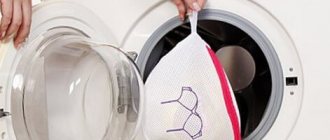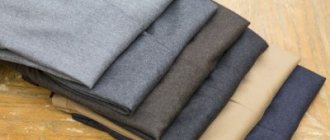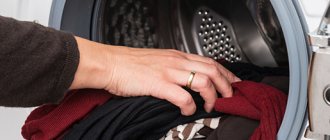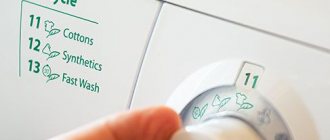1612.18
Author: Alla
No comments yet
Socks get dirty more than any other item and it takes a lot of effort to wash them. Sometimes you even have to download them for a long time.
Absolutely every housewife is familiar with the difficult task of washing socks. But how can this task be simplified? This is exactly what will be discussed in this article.
You can wash socks in several ways: by hand, in a washing machine, with pre-soaking or pre-washing.
How to wash socks in a washing machine
Socks are washed inside out. To prevent vapors from getting lost, it is recommended to put them in a laundry bag. You can also use an old pillowcase. Do not stuff the bag too tightly. There should be space so that the socks can be washed thoroughly.
The detergent and program are selected according to the type of fabric. Therefore, it is important to pre-sort the products.
Choice of funds
It is best to use liquid powder for delicate items. It completely dissolves, does not remain in the fabric and is easily washed out. The socks remain soft after washing.
You can also add stain removers and bleaches to your washing machine. To keep the fabric clean longer, it is recommended to add conditioner. It creates a thin protective film that repels dirt.
It is unacceptable to use conditioner on wool items. A thin film will make the item less elastic and soft.
At what temperature should you wash socks?
Delicate fabrics are washed at 30–40 °C, natural fabrics at 40–60 °C. The temperature should not be high if there are stains of protein origin on the fabric, for example, fat, pores, blood. Hot water causes the protein to coagulate and become firmly stuck in the fibers. In addition, frequent hot washes thin out the fibers. It is better to use cold or lukewarm water.
What mode should you use to wash socks?
Any washing mode is suitable in accordance with the density and characteristics of the material. It is better to wash synthetics on a delicate program with a large volume of water. The number of revolutions should not exceed 600. If elastic fabrics, such as polyester or wool, are washed, it is better to turn off the spin cycle.
Cotton is washed on the appropriate cycle. The number of revolutions can be increased to 800. It is recommended to wash very dirty cotton socks using the soak program.
It is more hygienic to wash children's socks separately from adult items.
Removing paint from shoes
Often, the main problem that lovers of light-colored clothing encounter is the dyeing insole of their shoes.
Even after several hours of wearing, we are saddened to admit the fact that our favorite socks have turned dark due to low-quality shoe dyes. In this case, do not despair, because there are a number of effective methods on how to wash white socks from dirt.
For cotton items, bleach containing chlorine is ideal. For these purposes, you can safely use Domestos or any other similar special product containing chlorine.
Dilute Domestos with water in proportions of 1 to 1 and apply the resulting solution using a cotton swab to problem areas.
It is worth remembering that chlorine is a potent substance, and therefore it is forbidden to leave it on things for a long time.
After soaking, it must be thoroughly rinsed and washed.
For woolen and synthetic products, you can use pure juice obtained from lemon. It is enough to squeeze a few drops onto the contaminated material and wait 10-15 minutes, then wash it.
If the result is not satisfactory, you can use peroxide.
To effectively wash white socks from black soles, the concentration of peroxide can be doubled.
Thus, you will need to dilute 2 tablespoons of the product per 1 liter of water and keep the items in it for 10-15 minutes, then rinse in warm water.
To remove stubborn dirt from the soles, you can use a combination of sodium percarbonate and dishwashing detergent.
After mixing these mixtures in equal proportions, add a little water and apply the resulting mixture to areas that cannot be washed. After about an hour, wash the socks by hand. This method usually does a great job of restoring clothes to their original appearance.
How to wash thermal socks
Proper washing will preserve heat-resistant properties. What conditions must be observed when washing thermal socks automatically and manually:
- temperature – 40 °C;
- product – detergent gel or soap;
- a large amount of water;
- no spin;
- drying at room temperature.
The fibers of thermal socks do not withstand mechanical cleaning, so you should not rub or twist the fabric. It is unacceptable to use brushes and abrasives. It is enough to hold the socks in soapy water, knead them with your hands and rinse several times.
Removing gray spots and yellowness
As a result of frequent washing, light-colored items tend to darken and lose their former appearance. In this case, do not rush to throw away your socks.
There are several miraculous ways to help restore your snow-white appearance:
- Severely grayed items can be bleached using turpentine. Take 3 tablespoons of liquid with a pungent odor and dilute it in a 10-liter bucket of water, adding a few tablespoons of regular washing powder. After thoroughly stirring, leave the items in the resulting mixture overnight, then wash as usual.
- Chlorine-containing products also do an excellent job of removing gray spots and yellow discoloration. However, they can only be used on clothing items made of cotton. Pour 2 tablespoons of liquid into 2 liters of water and add 100 grams of washing powder. After thoroughly mixing the mixture, leave the clothes in it for one night, then wash them.
- You can make a stain remover at home using hydrogen peroxide and ammonia. To do this, mix the ingredients in proportions of 1 to 2 and apply the mixture to problem areas.
- Another bleaching method is to use a mixture of laundry detergent and dishwashing detergent. To prepare it, you need to squeeze out a few drops of washing liquid into one tablespoon of powder and foam it. Apply the solution directly to stubborn stains and wash with your hands after 10-15 minutes.
- An equally effective way to return things to a presentable appearance is to use special stain removers. A wide range of store-bought products offer many different ingredients for whitening items. When using stain removers, it is recommended to follow the instructions exactly to avoid unforeseen situations.
Please note that it is advisable to dry things away from sunlight. Otherwise, the yellowness may return and it will no longer be possible to remove it.
The best option would be to dry it outside in the shade, which will also help rid things of a specific smell.
Important. When using special chemicals, it is recommended to limit the time they remain on the fabric to a minimum. Otherwise, damage to the fiber structure may occur.
Additional recommendations
Washing socks should not be taken lightly. This part of the wardrobe carries a large number of bacteria, and in addition, wears out quickly. To avoid spreading germs to other clothes and to extend their lifespan, it is important to mix and dry socks correctly.
What you can wash with and what you can’t wash with
For hygiene reasons, it is not recommended to combine socks with underwear. You should also wash separately from clothes with Velcro or hooks, which may leave snags or tear the material. The couples will be accompanied by jeans, stockings, and tights.
If you have nail fungus, wash your socks by hand separately from other clothes. It is recommended to soak your socks every evening before the main wash in water with vinegar, hydrogen peroxide or chlorhexidine.
Drying rules
After washing, the socks should be hung on the dryer and left to dry at room temperature. It is convenient to use a hanging dryer with clothespins. It saves space and dries vapors without kinks.
Drying on a radiator or heated towel rail is not recommended, especially if the socks are made of synthetics. This will lead to shrinkage of the products. Woolen pairs are dried only in a horizontal position away from heating appliances.
To wash socks, you need to follow simple rules: turn them inside out, put them in an automatic washing bag, and use liquid detergents. Dirt will be washed off easier if you pre-soak the items in cool water.
Why can’t you wash them together with underwear (T-shirts, panties) and children’s clothes?
Many people are faced with the problem of fungal diseases of the feet and nails. Pathogenic spores actively reproduce in a damp, dark environment. To prevent spores from getting on the clothes of all family members, it is recommended to use special disinfecting solutions for soaking such items.
If there is fungus, it is necessary to soak things with boric acid or potassium permanganate to disinfect. Dissolve potassium permanganate in 100 ml of water so that the solution turns out to be dark purple in color and pour into 5 liters of warm water. Moisten things, rub with laundry soap and soak in the resulting solution for 1-3 hours. Don't be alarmed by the dirty brown color, this is a reaction. After soaking in this way, subsequent washing is not necessary, just rinse well.
This method is also suitable for children's things; in this case, it is better to replace laundry soap with baby soap.
Tip: Most washing and soaking products are harmful to the skin, so save your hands and wash with gloves.
After soaking, rinse items and, if necessary, machine wash. Now all that remains is to dry them properly.
Preparing dirty items for washing
Before you start washing, your socks need to be properly prepared. Basic recommendations:
Sort socks by color. White, black and colored items are washed separately.- Remove all visible dirt from socks. This could be threads, hair and other dirt.
- Turn the socks inside out. Sometimes it happens that small objects, pebbles and other debris get inside the product.
- Walk over the surface of the product with a machine to remove pellets.
If there are serious stains on the socks, they need to be soaked. If machine processing is intended, then you can select a special “wash with soak” program. To enhance the effect, a stain remover is added to the powder.
Soaking items during hand washing can be done using several methods:
- In a basin with the selected detergent.
- In polyethylene film. Socks are soaped and placed in a bag, leaving for 30-60 minutes.
When the preparatory activities are completed, you can begin washing the product.
Laundry bag
A bag for washing socks is a mesh product that is secured with laces or a zipper.
Its use allows you to solve several problems at once:
- Avoid socks getting tangled if they are loaded in large quantities at once or with other underwear.
- Extend the service life of the product. The mesh will be subject to friction against the drum of the washing machine, not the socks themselves.
- Do not harm the quality of the socks during spinning.
There are several types of bags. Small cases hold up to 2 pairs of socks. The cost of such a bag is 270 rubles.
You can also find large nets on sale, divided into 3 sections by partitions . For example, a product from Artmoon (250 rubles per piece). You can purchase mesh in hardware stores and online markets.
Make your own bleach at home
- Mix three tablespoons of hydrogen peroxide with one spoon of ammonia. Add the resulting contents to three liters of heated water. Socks are soaked in this bleach for the whole day and then washed.
- For white socks with colored patterns, we will prepare a stain remover. Take some toothpaste and mix it with hydrogen peroxide. Apply the product only to the stains for a few minutes. There will be no stains left after rinsing. In both cases, we pre-wash the socks with laundry soap to get rid of excess dirt.
- Regular vinegar will work too. Dilute a glass of vinegar in one and a half liters of water and boil the contents. Leave the socks in the solution for up to ten hours, then wash as usual.
- Light and fresh stains can be removed using any dish soap. Apply it to the stain for about thirty minutes, then wash and dry.
- If none of the methods help, and you don’t want to throw away your socks, citric acid or lemon juice is the most powerful and effective remedy. Mix one of the ingredients with baking soda, add it to cold water and bleach for thirty minutes before washing. The socks will become clean and white.
As you can see, there are quite a lot of ways. White things need proper care. Do not store socks with other dirty laundry for a long time. Don't forget to pre-soak and bleach. And your socks will always look perfect. If it is impossible to wash, buy new ones, these are just socks.
What to remember
- Do not wear your laundry, wash it regularly so that dirt comes off easily, and things do not lose their shape and retain their aesthetic appearance longer.
- Consider the type of fabric when washing: synthetic and wool socks will not withstand high temperatures, and only cotton items can be boiled.
- Be careful with chlorine bleaches - frequent use will wear out the material.
- When washing by hand, do not rub or twist the socks to avoid damaging the fabric.
- Before purchasing a bleach or stain remover, carefully read the instructions and make sure that the product is suitable for washing white socks of a particular material.
Boiling rules
In order to wash white socks as quickly and efficiently as possible, many housewives resort to boiling. This procedure requires compliance with a number of rules:
- First of all, it is recommended to select a container. This should be a pan made of stainless steel or enameled. Galvanized and aluminum containers are not suitable, because when heated they form oxides, which can cause the item to acquire a rusty tint. The pan must be large enough, otherwise the foam will “run away”.
- Do not boil delicate fabrics, wool or synthetics. Only linen and cotton can be used. For this purpose, only baby soap or gentle powders should be used. For a kilogram of dry laundry you will need a container with a volume of 12 liters.
- You can only load laundry into cool water, because boiling water fixes dirt, thereby complicating the washing process.
- Things should be boiled over low heat, stirring regularly. For these purposes, you need to use unpainted wooden tongs. If things were pre-soaked, then they should be boiled for about 30-40 minutes. If not, the duration of the process should be at least one and a half hours from the moment the solution boils.
You can remove products from the pan only after the water has cooled.











